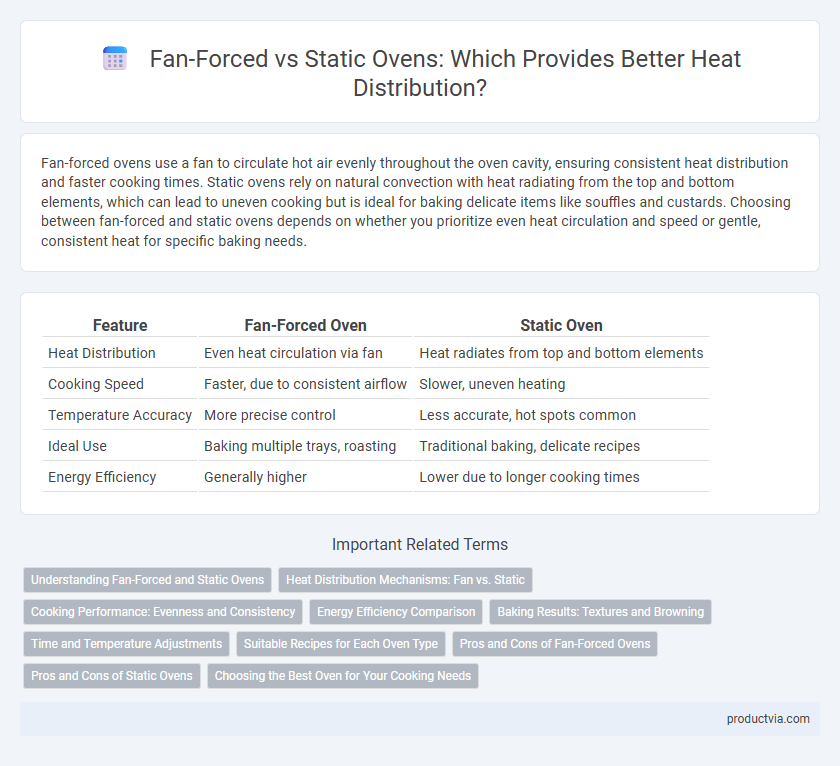Fan-forced ovens use a fan to circulate hot air evenly throughout the oven cavity, ensuring consistent heat distribution and faster cooking times. Static ovens rely on natural convection with heat radiating from the top and bottom elements, which can lead to uneven cooking but is ideal for baking delicate items like souffles and custards. Choosing between fan-forced and static ovens depends on whether you prioritize even heat circulation and speed or gentle, consistent heat for specific baking needs.
Table of Comparison
| Feature | Fan-Forced Oven | Static Oven |
|---|---|---|
| Heat Distribution | Even heat circulation via fan | Heat radiates from top and bottom elements |
| Cooking Speed | Faster, due to consistent airflow | Slower, uneven heating |
| Temperature Accuracy | More precise control | Less accurate, hot spots common |
| Ideal Use | Baking multiple trays, roasting | Traditional baking, delicate recipes |
| Energy Efficiency | Generally higher | Lower due to longer cooking times |
Understanding Fan-Forced and Static Ovens
Fan-forced ovens utilize a built-in fan and exhaust system to circulate hot air evenly, resulting in consistent heat distribution and faster cooking times. Static ovens rely on natural heat rising from the bottom and top elements, creating varying temperatures with hotspots, which can affect baking uniformity. Understanding these differences helps optimize cooking methods, as fan-forced ovens suit roasting and multi-shelf baking, while static ovens excel in items requiring gentle, steady heat like bread and pastries.
Heat Distribution Mechanisms: Fan vs. Static
Fan-forced ovens utilize a powerful fan and exhaust system to circulate hot air evenly throughout the oven cavity, promoting consistent heat distribution and faster cooking times. Static ovens rely on natural convection, where heat rises from the bottom elements, resulting in uneven temperature zones that require manual rotation of food for uniform cooking. The fan mechanism in fan-forced ovens minimizes hot spots and cold areas, making them ideal for baking multiple trays simultaneously with precise, reliable results.
Cooking Performance: Evenness and Consistency
Fan-forced ovens use a convection fan to circulate hot air, ensuring even heat distribution and consistent cooking results across all shelves, reducing hotspots and uneven browning. Static ovens rely on natural heat convection with heat typically rising from the bottom element, which can lead to uneven cooking and requires rotating dishes for more uniform results. For precise and repeatable cooking performance, fan-forced ovens offer superior evenness and consistency compared to static ovens.
Energy Efficiency Comparison
Fan-forced ovens use a built-in fan to circulate hot air evenly, resulting in faster cooking times and reduced energy consumption compared to static ovens that rely on natural heat circulation. This efficient heat distribution in fan-forced ovens minimizes hot spots and ensures consistent temperatures, making them more energy-efficient for baking and roasting. Static ovens typically require longer preheating and cooking durations, which can lead to higher electricity usage and less effective heat utilization.
Baking Results: Textures and Browning
Fan-forced ovens use a convection fan to circulate hot air, promoting even heat distribution that results in consistent textures and efficient browning on baked goods. Static ovens rely on radiant heat from the top and bottom elements, which can create uneven cooking zones, often yielding denser textures and less uniform browning. For delicate pastries or recipes requiring precise crust development, fan-forced ovens typically enhance overall baking quality and appearance.
Time and Temperature Adjustments
Fan-forced ovens utilize a convection fan to circulate hot air evenly, allowing food to cook faster and at lower temperatures compared to static ovens. Static ovens rely on radiant heat from the top and bottom elements, often requiring longer cooking times and higher temperatures to achieve even heat distribution. Adjusting recipes for fan-forced ovens typically involves reducing temperature by 20degC and shortening cooking times by up to 30%, enhancing energy efficiency and precision in baking.
Suitable Recipes for Each Oven Type
Fan-forced ovens use a convection fan to circulate hot air evenly, making them ideal for roasting meats, baking cookies, and cooking dishes requiring consistent heat distribution. Static ovens rely on traditional radiant heat from the top and bottom elements, which works best for baking bread, pastries, and delicate cakes that benefit from gradual rising. Choosing the right oven type enhances texture and flavor by matching the heat distribution method to the recipe's specific requirements.
Pros and Cons of Fan-Forced Ovens
Fan-forced ovens use a built-in fan to circulate hot air, ensuring even heat distribution and faster cooking times, particularly useful for baking and roasting multiple dishes simultaneously. These ovens offer energy efficiency and consistent temperature control but may dry out food faster or create uneven browning on certain baked goods like cakes. While fan-forced ovens excel in versatility and speed, static ovens provide gentler, steadier heat ideal for delicate baking tasks.
Pros and Cons of Static Ovens
Static ovens provide even heat distribution through indirect, radiant heat, ideal for baking bread and delicate pastries without the risk of uneven drying. These ovens avoid circulating air, reducing the chance of food drying out but may result in longer cooking times and hot spots in larger ovens. Lack of fan circulation means slower temperature recovery, which can affect cooking consistency when multiple dishes are prepared simultaneously.
Choosing the Best Oven for Your Cooking Needs
Fan-forced ovens circulate hot air with a built-in fan, ensuring even heat distribution and faster cooking times, ideal for baking multiple trays simultaneously. Static ovens rely on radiant heat from the top and bottom elements, providing traditional cooking results best suited for delicate dishes like souffles or roasting. Selecting the best oven depends on your cooking style: fan-forced offers efficiency and consistency, while static ovens give precise, gentle heat.
Fan-forced vs Static Oven for heat distribution Infographic

 productvia.com
productvia.com